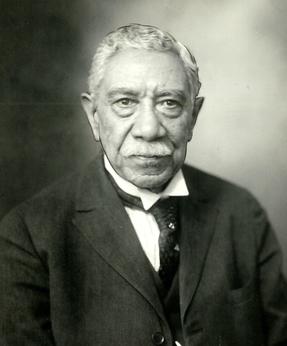John Patterson Green facts for kids
John Patterson Green (born April 2, 1845 – died September 1, 1940) was an American lawyer, politician, and writer. He was one of the first African Americans to hold public office in Cleveland, Ohio. As a member of the Republican Party, he became a Justice of the Peace in 1873. He also served in the Ohio House of Representatives in 1882. Later, in 1891, he was elected to the Ohio Senate. This made him the first African American state senator in Ohio's history. John P. Green is especially remembered for creating the law that made Labor Day a state holiday in Ohio.
Contents
Early Life and Education
John P. Green was born in New Bern, North Carolina. His parents, John Rice Green and Temperance Dirden Green, were free people of color. His father was a tailor and his mother was a seamstress. When John was five, his father died. His mother then raised him and his two sisters.
In 1857, his mother moved the family to Cleveland, Ohio. She hoped to find better schools and job chances there. Cleveland was known for being a welcoming city. White leaders there encouraged fairness and integration, even before the Civil War. This meant black children could attend schools with white children. People of color could also go to public events.
In Cleveland, Green went to local schools, which were already integrated. He also worked odd jobs to help his family. He was an errand boy and later a hotel waiter. He studied a lot on his own. In 1866, he wrote a small book called Miscellaneous Subjects by a Self-Educated Colored Youth. He sold nearly 1,500 copies to earn money for his education.
Green finished a four-year program at Cleveland Central Catholic High School in just two years. He was the top student in his class, known as the Valedictorian. After high school, he went to Ohio State and Union Law College in Cleveland. He graduated from law school in 1870.
Political Career and Public Service
After law school, Green moved to Bennettsville, South Carolina, from 1870 to 1872. He passed the South Carolina bar exam in 1870 and began working as a lawyer. In 1872, he was chosen as a delegate for the South Carolina Republican convention.
In late 1872, Green returned to Cleveland. He was elected as a Justice of the Peace for Cuyahoga County, Ohio. He won by a large number of votes. He served three terms and handled about 12,000 legal cases.
Green ran for the Ohio House of Representatives in 1877 but lost. He ran again in 1881 and won. He lost in 1883 but won again in 1889. In 1890, he created a law to make Labor Day a state holiday in Ohio. In 1891, Green was elected to the Ohio Senate. Most of the voters who elected him were white.
As a senator, he supported funding for Wilberforce University. This school was connected to the African Methodist Episcopal Church. He also helped stop efforts to allow schools to separate students by race.
Green was a strong supporter of the Republican Party. He traveled and spoke during William McKinley's presidential campaign in 1896. Because of his efforts, he was given a new job in 1897. He became the U.S. Postage Stamp Agent in Washington, D.C.. He worked there from 1897 to 1905. In 1906, he briefly served as a superintendent in the United States Post Office Department.
Green was a respected lawyer in Cleveland. He often helped working-class people.
Later Life and Legacy
John P. Green continued to practice law as he got older. In 1920, he finished his autobiography, Fact Stranger than Fiction. He wrote this book for young African Americans.
In 1928, Green spoke at the Republican National Convention in Chicago. He asked black voters to support the Republican party.
He died in 1940 after being hit by a car in Cleveland. He was one of the oldest practicing lawyers in Ohio at the time. Green is buried in Woodland Cemetery in Cleveland, Ohio.
Green helped start St. Andrew's Episcopal Church in Cleveland.
Family Life
Green married Annie Laura Walker Green (1848–1912) in 1869. They had four children who lived to adulthood: William R. Green, Theodore B. Green, Jessie Bishop Green, and Clara Green. William R. Green later became the president of the Cleveland NAACP. After Annie died in 1912, John married Lottie Mitchell Richardson in September 1912. They had two children together.
His Impact
The Cleveland Leader newspaper called Green a "self-made man" in 1902. He came to Cleveland at age twelve and used education to improve his life. He also used politics to move up in society. He became an important person in the Ohio Republican Party. Green was the second African American to serve in the Ohio House of Representatives. He was also the first to serve in the Ohio Senate.
Green believed in social and cultural integration for black Clevelanders. He thought that hard work and saving money were important for achieving equality.
In Ohio, Green is remembered for creating the bill that made Labor Day a state holiday in 1890. He was often called Ohio's Father of Labor Day. When Labor Day became a national holiday in 1894, some even called him the Father of Labor Day.
In 1937, the mayor and city council of Cleveland honored him. They named April 4th "John P. Green Day" to recognize his service to the city.
Works
- Miscellaneous Subjects by a Self-Educated Colored Youth. Cleveland, 1866.


